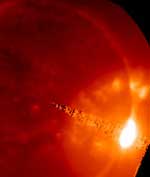
Image credit: NOAA
A massive flare erupted on the surface of the Sun yesterday that was so bright that it temporarily blinded the instruments on solar observation satellites. Astronomers believe this was the brightest flare that has ever been seen in modern times. Fortunately, this flare, and the following coronal mass ejection fired off to the side of the Sun, so very little material is expected to reach the Earth. The most powerful flares are the X-class; the most powerful flare ever seen before now was an X-20, but this could be an X-30, or even higher.
The NOAA Space Environment Center in Boulder, Colo., reports that an intense explosion occurred on the sun Tuesday at 2:29 p.m. EST. The violent eruption saturated X-ray detectors on NOAA?s GOES satellite, which monitors the sun and produces a new image every minute. NOAA space weather forecasters are still analyzing the event to see if this solar explosion will trigger another bout of radiation and geomagnetic storms. (Click NOAA satellite image for larger view of sun taken on Nov. 4, 2003, at 3:14 p.m. EST. Click here to view latest solar images. Please credit ?NOAA.?)
The explosion occurred in NOAA Region 486, an area that was about to rotate out of view of the Earth. This storm may only deal a glancing blow at the Earth given the position of the solar eruption. This region of the sun will be squarely aimed at Earth once again during Thanksgiving week.
(Click here to view mpeg animation of the sun with the latest solar eruption. The images begin Nov. 3 at 4:06 p.m. EST and end on Nov. 4 at 4:02 p.m. EST. Please note that this is a large file. Please credit “NOAA.”)
NOAA scientists are amazed at the amount of solar activity during the last two weeks. During this cycle of the sun, almost four years past solar maximum, explosions of this magnitude are a rarity.
NOAA forecaster Bill Murtagh said that a radio blackout is in progress. ?This is an R-5 extreme event. They don?t get much bigger than this.? An R-5 event is at the top of the NOAA space weather scales, which run 1 to 5.
Original Source: NOAA News Release
